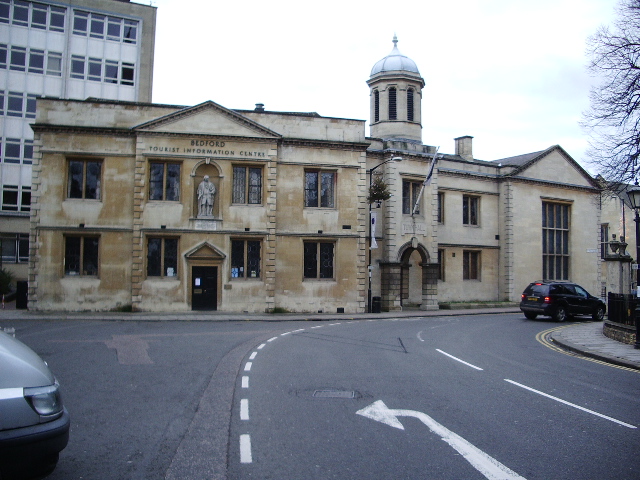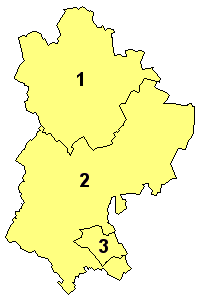|
Cotton End
Cotton End is a small village and civil parish on the outskirts of Bedford. It became its own parish as of 1 April 2019, having previously been part of the parish of Eastcotts. Ordnance Survey maps from the 1880s show its name as 'Cardington Cotton End'. There is a primary school, a Baptist church, a village hall and a pub. The Baptist chapel was founded here in 1777. In 1912, Cotton End was described as a scattered hamlet with a school and a farm. It lies further down the A600 road from Shortstown. A new woodland created by the Forest of Marston Vale The Forest of Marston Vale is an evolving community forest in Marston Vale, which runs south west from the towns of Bedford and Kempston in Bedfordshire, England towards the M1 motorway. It is operated by a registered charity called the Forest ... in 2005 called Shocott Spring. References External links Villages in Bedfordshire Civil parishes in Bedfordshire Borough of Bedford Populated places established in 20 ... [...More Info...] [...Related Items...] OR: [Wikipedia] [Google] [Baidu] |
North East Bedfordshire (UK Parliament Constituency)
North East Bedfordshire is a constituency represented in the House of Commons of the Parliament of the United Kingdom since 2019 by Richard Fuller, of the Conservative Party. Constituency profile This is a mainly rural, professional area, with medium level incomes, low unemployment and a low proportion of social housing. The East Coast Main Line The East Coast Main Line (ECML) is a electrified railway between London and Edinburgh via Peterborough, Doncaster, York, Darlington, Durham and Newcastle. The line is a key transport artery on the eastern side of Great Britain runni ... runs through the east part of the seat, with several stations connecting to Central London. Boundaries and boundary changes 1997–2010: The District of Mid Bedfordshire wards of Arlesey, Biggleswade Ivel, Biggleswade Stratton, Blunham, Langford, Northill, Old Warden and Southill, Potton, Sandy All Saints, Sandy St Swithun's, Stotfold, and Wensley; and the Borough of Bedford ward ... [...More Info...] [...Related Items...] OR: [Wikipedia] [Google] [Baidu] |
Borough Of Bedford
The Borough of Bedford is a unitary authority area with borough status in the ceremonial county of Bedfordshire, England. Its council is based in Bedford, its namesake and principal settlement, which is the county town of Bedfordshire. The borough contains one large urban area, the 71st largest in the United Kingdom that comprises Bedford and the adjacent town of Kempston, surrounded by a rural area with many villages. 75% of the borough's population live in the Bedford Urban Area and the five large villages which surround it, which makes up slightly less than 6% of the total land area of the Borough. The borough is also the location of the Wixams new town development, which received its first residents in 2009. Formation The ancient borough of Bedford was a borough by prescription, with its original date of incorporation unknown. The earliest surviving charter was issued c. 1166 by Henry II, confirming to the borough the liberties and customs which it had held in the reig ... [...More Info...] [...Related Items...] OR: [Wikipedia] [Google] [Baidu] |
Bedfordshire
Bedfordshire (; abbreviated Beds) is a ceremonial county in the East of England. The county has been administered by three unitary authorities, Borough of Bedford, Central Bedfordshire and Borough of Luton, since Bedfordshire County Council was abolished in 2009. Bedfordshire is bordered by Cambridgeshire to the east and north-east, Northamptonshire to the north, Buckinghamshire to the west and Hertfordshire to the south-east and south. It is the fourteenth most densely populated county of England, with over half the population of the county living in the two largest built-up areas: Luton (258,018) and Bedford (106,940). The highest elevation point is on Dunstable Downs in the Chilterns. History The first recorded use of the name in 1011 was "Bedanfordscir," meaning the shire or county of Bedford, which itself means "Beda's ford" (river crossing). Bedfordshire was historically divided into nine hundreds: Barford, Biggleswade, Clifton, Flitt, Manshead, Redborne ... [...More Info...] [...Related Items...] OR: [Wikipedia] [Google] [Baidu] |
Bedford
Bedford is a market town in Bedfordshire, England. At the 2011 Census, the population of the Bedford built-up area (including Biddenham and Kempston) was 106,940, making it the second-largest settlement in Bedfordshire, behind Luton, whilst the Borough of Bedford had a population of 157,479. Bedford is also the historic county town of Bedfordshire. Bedford was founded at a ford on the River Great Ouse and is thought to have been the burial place of King Offa of Mercia, who is remembered for building Offa's Dyke on the Welsh border. Bedford Castle was built by Henry I, although it was destroyed in 1224. Bedford was granted borough status in 1165 and has been represented in Parliament since 1265. It is known for its large population of Italian descent. History The name of the town is believed to derive from the name of a Saxon chief called Beda, and a ford crossing the River Great Ouse. Bedford was a market town for the surrounding agricultural region from the early Middle ... [...More Info...] [...Related Items...] OR: [Wikipedia] [Google] [Baidu] |
Eastcotts
Eastcotts is an electoral ward within the Borough of Bedford. It was formerly also a civil parish until its abolition on 1 April 2019, when Cotton End and Shortstown parishes were established. The boundaries of Eastcotts are approximately Exeter Wood to the east, Bedfordshire Greensand Ridge to the south and Shocott Spring to the west. There are two woodlands; Shocott Spring and Exeter Wood, two villages; Shortstown and Cotton End and two hamlets; Harrowden and Herrings Green. And some landmarks such as the Cardington Sheds. History Eastcotts Castle a small motte castle constructed of timber was built during the 11th or 12th century. Located on the Bedfordshire Greensand Ridge, it overlooked the parish to the north. In 1831 Eastcotts was described as a chapelry in the parish of Cardington, in the hundred of Wixamtree, miles south-east of Bedford. In 1915 Short Brothers bought land in the parish to build airships for the Admiralty and constructed a 700-foot-long ( ... [...More Info...] [...Related Items...] OR: [Wikipedia] [Google] [Baidu] |
Local Government Boundary Commission For England
The Local Government Boundary Commission for England (LGBCE) is a parliamentary body established by statute to conduct boundary, electoral and structural reviews of local government areas in England. The LGBCE is independent of government and political parties, and is directly accountable to the Speaker's Committee of the House of Commons. History and establishment The Local Democracy, Economic Development and Construction Act 2009, which received royal assent on 12 November 2009, provided for the establishment of the Local Government Boundary Commission for England (LGBCE), and for the transfer to it of all the boundary-related functions of the Boundary Committee for England of the Electoral Commission. The transfer took place in April 2010. Responsibilities and objectives The Local Government Boundary Commission for England is responsible for three types of review: electoral reviews; administrative boundary reviews; and structural reviews. Electoral reviews An electoral ... [...More Info...] [...Related Items...] OR: [Wikipedia] [Google] [Baidu] |
A600 Road
List of A road A roads may be *motorways or freeways, usually where the local word for motorway begins with A (for example, ''Autobahn'' in German; ''Autostrada'' in Italian). * main roads or highways, in a system where roads are graded A, B and sometimes lower c ...s in zone 6 in Great Britain starting east of the A6 and A7 roads, and west of the A1 (road beginning with 6). Single- and double-digit roads Triple-digit roads Four-digit roads (60xx) Four-digit roads (61xx and higher) References {{UK road lists 6 6 ... [...More Info...] [...Related Items...] OR: [Wikipedia] [Google] [Baidu] |
Shortstown
Shortstown is a village and civil parish on the outskirts of Bedford, on a ridge above the River Great Ouse, originally called Tinkers Hill. This ridge also overlooks the two other parts of Eastcotts – Harrowden to the north and Cotton End to the south. The name is taken from Short Brothers. The Admiralty established an airship works for the company in 1916. The company pulled out of airship work just three years later, but the name Shortstown stuck. Transport Road access to the village is provided by the A600 road. The Stagecoach bus also runs frequent routes in the village, with Route 9 running to and from the town centre at frequent intervals. Routes 9A and 9B also provide connections to Bedford as well as the nearby locations of Cotton End and Shefford, continuing on to Hitchin. Village history Shortstown was built on Tinker's Hill, Harrowden. Before it was built, a windmill stood on the site from 13th to 16th century. From 17th to 18th century, the area was known ... [...More Info...] [...Related Items...] OR: [Wikipedia] [Google] [Baidu] |
Forest Of Marston Vale
The Forest of Marston Vale is an evolving community forest in Marston Vale, which runs south west from the towns of Bedford and Kempston in Bedfordshire, England towards the M1 motorway. It is operated by a registered charity called the Forest of Marston Vale Trust. The vale is traditionally a brickmaking area, but brickmaking industry has been running down since the 1970s. It has left a large amount of spoiled countryside containing several large empty pits some of which have now been converted into lakes. The Forest of Marston Vale is one of twelve of community forest projects in the United Kingdom. It was initiated by the Countryside Agency and the Forestry Commission, in partnership with Bedfordshire County Council, Mid Bedfordshire District Council, and Bedford Borough Council Bedford Borough Council is the local authority of the Borough of Bedford in Bedfordshire, England. It is a unitary authority, having the powers of a non-metropolitan county and district council co ... [...More Info...] [...Related Items...] OR: [Wikipedia] [Google] [Baidu] |
Villages In Bedfordshire
A village is a clustered human settlement or community, larger than a hamlet but smaller than a town (although the word is often used to describe both hamlets and smaller towns), with a population typically ranging from a few hundred to a few thousand. Though villages are often located in rural areas, the term urban village is also applied to certain urban neighborhoods. Villages are normally permanent, with fixed dwellings; however, transient villages can occur. Further, the dwellings of a village are fairly close to one another, not scattered broadly over the landscape, as a dispersed settlement. In the past, villages were a usual form of community for societies that practice subsistence agriculture, and also for some non-agricultural societies. In Great Britain, a hamlet earned the right to be called a village when it built a church. [...More Info...] [...Related Items...] OR: [Wikipedia] [Google] [Baidu] |
Civil Parishes In Bedfordshire
A civil parish is a country subdivision, forming the lowest unit of local government in England. There are 125 civil parishes in the ceremonial county of Bedfordshire, most of the county being parished: Luton is completely unparished; Central Bedfordshire is entirely parished. At the 2001 census, there were 312,301 people living in the 125 parishes, which accounted for 55.2 per cent of the county's population. History Parishes arose from Church of England divisions, and were originally purely ecclesiastical divisions. Over time they acquired civil administration powers.Angus Winchester, 2000, ''Discovering Parish Boundaries''. Shire Publications. Princes Risborough, 96 pages The Highways Act 1555 made parishes responsible for the upkeep of roads. Every adult inhabitant of the parish was obliged to work four days a year on the roads, providing their own tools, carts and horses; the work was overseen by an unpaid local appointee, the ''Surveyor of Highways''. The poor were loo ... [...More Info...] [...Related Items...] OR: [Wikipedia] [Google] [Baidu] |




